List of olive cultivars
There are hundreds of cultivars of the olive (Olea europaea). As one of the oldest and more important domesticated crops raised by humans, the olive tree has diverged naturally and with the assistance of man into many varieties. Olive cultivars are first and foremost divided into their location of origin; most names for cultivars come from place names. Secondarily, olives may be preferred for olive oil production or for eating as table olives, though many cultivars are dual-purpose.
Table of olives
| Name | Image | Origin | Description |
|---|---|---|---|
| Amfissa | Greece | also called the Amphissis, is a common Greek table olive grown in Amfissa, Central Greece near the oracle of Delphi. Amfissa olives enjoy protected designation of origin (PDO) status, and are equally good for olive oil extraction. The olive grove of Amfissa, which consists of 1,200,000 olive trees is a part of a protected natural landscape. | |
| Arbequina | |
Spain | a small, brown olive grown in Aragon and Catalonia, Spain, good for eating and for oil. |
| Arbosana | Spain | a Spanish variety commonly grown for oil production alongside Arbequina and others, including in the United States. | |
| Ascolano | USA | a cold-hardy table variety grown in California.[1] | |
| Ayvalık | Turkey | or Edremit is popular olive type which is produced mostly for oil. The name is coming from the Turkish cities in North Aegean, Ayvalık - Edremit[2] | |
| Barnea | Israel | a modern dual-purpose cultivar bred originally from Kadesh Barnea in southern Israel to be disease-resistant and to produce a generous crop. The oil has a strong flavour with a hint of green leaf. Barnea is widely grown in Israel and in the southern hemisphere, particularly in Australia and New Zealand. | |
| Bidni |  |
Malta | Malta's indigenous, disease resistant, cultivar. The fruit is famously known for its superior oil and its beautiful dark violet colour at maturity. |
| Bosana | 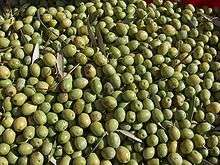 |
Italy | the most common olive grown on Sardinia. It is used mostly for oils. |
| Bouteillan | France | a cultivar grown in France for olive oil. | |
| Cailletier | _CL._J_Weber_(6)_(23148311055).jpg) |
France | grown primarily in the Alpes-Maritimes region near Nice and in nearby Liguria in Italy, where it is known as Taggiasca. When processed for salads it is known as Niçoise. |
| Castelvetrano | see Nocellara del Belice | ||
| Cayon | France | an olive oil variety grown in Southern France. | |
| Cerignola | 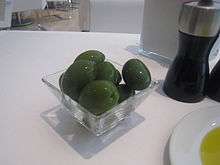 |
Italy | originates from the south-eastern Italian province of Apulia, are very large, mild in flavor, and may be served either green or cured red or black. |
| Cobrançosa | Portugal | a variety cultivated in Portugal. | |
| Conservolea | Greece | a table olive cultivar, a mainstay of the Greek olive industry, same to Amphisis | |
| Coratina | Italy | one of the most important Italian varieties, especially favoured in the area of Puglia, the largest olive growing area of Italy. | |
| Cornicabra | Spain | originating in Toledo, Spain, comprises about 12% of Spain's production. It is mainly used for oil. It is the main variety of olive used to make olive oil in Algeria.[3] | |
| Domat | Turkey | a common Turkish green olive, a table olive and grown for oil[2][4] | |
| Dritta | Italy | a variety of olive tree typical of the DOP area known as Aprutino Pescarese in the province of Pescara (Abruzzo). Its olives yield an extra virgin olive oil featuring extraordinary chemical and organoleptic qualities. | |
| Empeltre | _(20257197963).jpg) |
Spain | from Pedrola, Aragon, a medium-sized black olive grown in Spain. Especially in Aragon and the Balearic Islands, it is also dual-purpose. |
| Frantoio |  |
Italy | and Leccino a principal raw material for Italian olive oils from Tuscany. Frantoio is fruity with a stronger aftertaste than Leccino. |
| Galega | Portugal | or Galega Vulgar, is a variety cultivated in Portugal. | |
| Gemlik | Turkey | a variety from the Gemlik area of northern Turkey. They are small to medium-sized black olives with a high oil content. This type of olive is very common in Turkey and is sold as a breakfast olive in the cured formats of either Yagli Sele, Salamura or Duble, though there are other less common curings. The sign of a traditionally cured Gemlik olive is that the flesh comes away from the pit easily. | |
| Halkidiki | Greece | very large table olives from the Halkidiki region of Greece; also called gaidouria, donkey olives[5] | |
| Hojiblanca | Spain | originated in the province of Córdoba, Spain; its oil is widely appreciated for its slightly bitter flavour | |
| Hondroelia | Greece | ('hondro=thick' olive, due to its size), a rare olive from Astros, blond, traditionally cured in salt[5] | |
| Izmir Sofralik | Turkey | a Turkish olive mostly grown for olive oil[2] | |
| Kalamata | 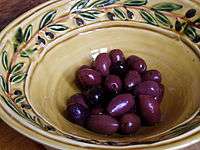 |
Greece | a large, black olive with a smooth and meatlike taste, is named after the city of Kalamata, Greece, and is used as a table olive. These olives are usually preserved in wine, vinegar or olive oil. Kalamata olives enjoy PDO status, and olives of this same cultivar grown outside the Kalamata region are markeded in the EU as Kalamon olives.[5] |
| Koroneiki | Greece | originated from the southern Peloponese, around Kalamata and Mani in Greece. This small olive, though difficult to cultivate, has a high yield of olive oil of exceptional quality. | |
| Kothreiki | Greece | a dual-purpose cultivar for oil and table olives | |
| Leccino | 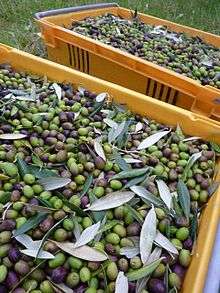 |
Italy | and Frantoio cultivars are the principal raw material for Italian olive oils from Tuscany. Leccino has a mild sweet flavour. |
| Lucques | 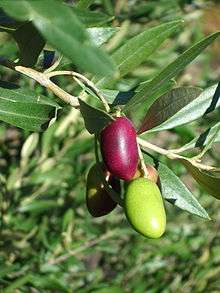 |
France | found in the south of France (Aude département). They are green, large, and elongated. The stone has an arcuated (bow) shape. Their flavour is mild and nutty. |
| Maalot | Israel | (Hebrew for merits) is a disease-resistant, Eastern Mediterranean cultivar derived from the North African Chemlali cultivar in Israel. The olive is medium-sized, round, has a fruity flavour and is used almost exclusively for oil production. | |
| Manzanilla |  |
Spain | a large, rounded-oval fruit, with purple-green skin, originated in Dos Hermanas, Seville, in southern Spain. "Manzanillas" means little apples in Spanish. Known for a rich taste and thick pulp, it is a prolific bearer, grown around the world. |
| Mastoidis | Greece | similar to Tsounati, is a Greek table olive cultivar.[6] | |
| Megaritiki | Greece | a dual-purpose cultivar for oil and table olives | |
| Memeli | Turkey | a Turkish olive used for split green olives, green olives in brine, black olives and olive oil. Clingstone.[2] | |
| Meslalla | Morocco | a Moroccan green olive used for olive oil production, pickled in garlic and hot peppers. It is also used in Tagines. | |
| Mission | 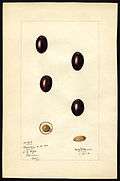 |
USA | originated on the California Missions and is now grown throughout the state. They are black and generally used for table consumption. |
| Nabali | Palestine | originated in Palestine[7] and is known locally as Baladi. | |
| Nafplion | Greece | a small green olive grown only in the Argos valley in Greece. Nafplion olives are traditionally cracked and cured in brine.[8] | |
| Nevadillo blanco | |||
| Nocellara del Belice | 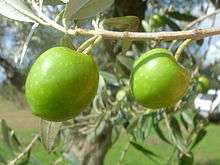 |
Italy | a large green olive cultivar primarily grown in Sicily. Also known as Castelvetrano olives in the United States, they have a mild, buttery flavor that makes them popular table olives, though they are also used to produce olive oil. |
| Patrinia | Greece | a Greek variety of olive tree grown primarily in Aigialeia, Greece. | |
| Picholine | _CL._J_Weber_(23148296045).jpg) |
France | grown in the south of France. It is green, medium size, and elongated. The flavour is mild and nutty. |
| Picual | Spain | from southern Spain (province of Jaén), is the most widely cultivated olive in Spain, comprising about 50% of Spain's olive production and around 20% of world olive production. It has a strong but sweet flavour, and is widely used in Spain as a table olive. | |
| Souri | Lebanon | grown in Lebanon near the town of Sur (Tyre) and widespread in the Levant, has a high oil yield and exceptionally aromatic flavour. | |
| Thassos |  |
Greece | the only cultivar that can be eaten straight from the tree when ripe.[5] |
| Throumbolia | Greece | a dual-purpose cultivar for oil and table olives | |
| Tsounati | see Mastoidis |
See also
References
- ↑ Vossen, Paul. "Growing Temperate Tree Fruit and Nut Crops in the Home Garden and Landscape" (PDF). University of California Cooperative Extension.
- 1 2 3 4 "Olive Growing in Turkey" (pdf). Körfez Grubu.
- ↑ "Common Olive Varietals by Country". About Olive Oil. Retrieved 10 July 2015.
- ↑ İsfendİyaroğlu, Murat & Özeker, Elmas (2012). "Root Regeneration of 'Domat' Olive (Olea europaea L.) Cuttings: Wounding Effects" (pdf). Ege Üniversitesi Ziraat Fakültesi.
- 1 2 3 4 Fotiadi, Elena (2006). "Unusual Olives". Epikouria Magazine (2).
- ↑ Sinha, N.; Hui, Y.H.; Evranuz, E.Ö.; Siddiq, M.; Ahmed, J. (2010). Handbook of Vegetables and Vegetable Processing. Wiley. p. 664. ISBN 9780470958445.
- ↑ a., Belaj; z., Satovic; l., Rallo; i., Trujillo (2002). "Genetic diversity and relationships in olive (Olea europaea L.) germplasm collections as determined by randomly amplified polymorphic DNA". TAG Theoretical and Applied Genetics. 105 (4): 638. doi:10.1007/s00122-002-0981-6.
- ↑ http://www.zingermans.com/article.aspx?articleid=article16
Further reading
- Diego Barranco Navero, ed. (2000). World Catalogue of Olive Varieties. International Olive Oil Council. ISBN 8493166316.
This article is issued from Wikipedia - version of the 10/10/2016. The text is available under the Creative Commons Attribution/Share Alike but additional terms may apply for the media files.